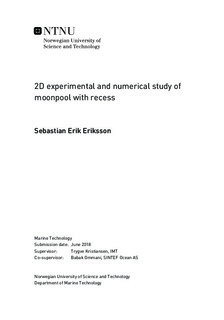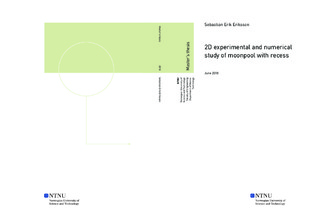| dc.description.abstract | The background for this master's thesis is the complications that is faced in the industry with regards to operational time inside moonpools. This thesis focuses on moonpools with recess, and the fluid resonant phenomena piston mode and sloshing. The main idea is that recess length, water depth in the shallow water zone above the recess and heave amplitude are important parameters. Strengths of model experiments, numerical simulations and potential theory is utilized.
In order to establish an overview of the background of this thesis, relevant work carried out by others are presented through a literature review.
Relevant theory is presented, and special attention is paid to potential theory. In detail the methods of matched eigenfunction expansions are described. The theory presented by \cite{molin2017natural} is utilized and adapted in order to match the present experimental setup investigated. Expressing the velocity potential in three subdomains by means of eigenfunction expansions, yields an eigenvalue problem providing estimates of the natural periods of piston mode and sloshing modes. These are used to construct compact experimental test matrices, and are also compared against experimental results. Findings show that the estimated natural periods are somewhat smaller than the ones obtained from experiments. A similar approach is used in order to implement the theory in six subdomains. This yields a boundary value problem in which results like Response Amplitude Operators(RAO) are obtained.
Two-dimensional forced heave experiments are conducted over two lab periods in the NTNU laboratory Ladertanken. Experiments are executed around piston mode and the first sloshing mode natural periods. Results indicate a strong dependency of draft on the linearity of the free surface in the shallow water zone above the recess. Results show that strong second harmonic oscillations are excited, and discussions are made on the applicability of theory on shallow and intermediate water sloshing in tanks with secondary resonance. Together with draft, recess length prove to be an important factor. The largest second harmonic response is obtained for recess length of half the moonpool length, at the shallowest drafts. The largest amplification of the first harmonic response is obtained for the second largest draft, with recess length of half the moonpool length. Strong viscous effects are observed with regards to forcing amplitude. Small resonance amplitudes are observed at piston mode resonance, which is consistent with similar experiments on clean moonpools.
Numerical simulations are carried out in OpenFOAM by implementing the hybrid code Potential Viscous Code 3D(PVC3D) developed at SINTEF Ocean. As the free surface is governed by linear potential flow conditions, investigations are made on its applicability in the shallow water zone above the recess. Numerical results are compared with experiments, and good correspondence are found for the largest draft tested with a deviation of 2.18$\%$. A brief refinement investigation is carried out, showing a clear mesh dependency on the accuracy. The code is also tested for more shallow drafts, and results indicates that the non-linearities are problematic for the solver. Neither the first or second harmonic signals are captured with satisfactory accuracy. | |

